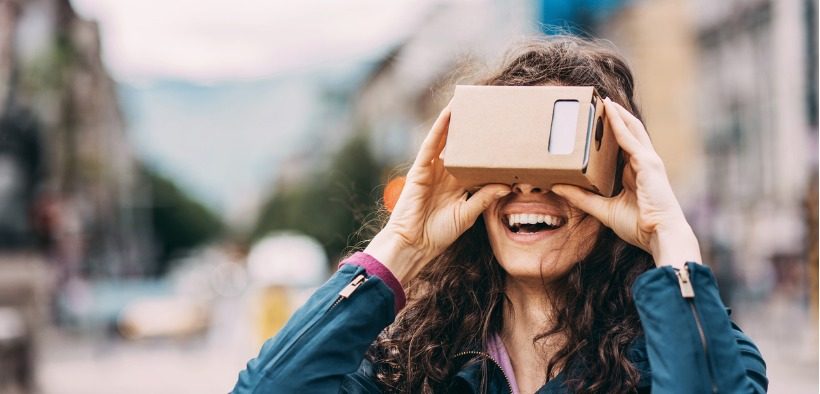The terms “virtual,” “augmented,” and “mixed” reality have been thrown around a lot lately in education, leaving many instructors understandably perplexed over their different meanings. Worse yet, discussions of these concepts often fail to adequately disconnect them from their gaming origin, making one wonder whether they have useful applications to education. The good news is that there are many educational uses of these applications, and a world of free educational content available to instructors. Better yet, most of these applications do not require expensive goggles or other equipment for making or viewing content.
Virtual reality
The term “virtual reality” has gone through three iterations. The first referred to an animated world that the user entered through their computer by taking the form of an avatar representation of themselves. Second Life was the most famous of these systems. Users could build homes and other structures, as well as interact with one another within the world.
A number of educational institutions started using into Second Life, most using it for recruiting purposes by designing a mockup of one of their halls that prospective students could explore. Champlain College went a step further by connecting its site to its gaming program. Students would learn to create game elements by adding to the school’s Second Life site, designing new buildings and even a concert venue that hosted live concerts put on by local musicians. Jean Haefner at the University of Wisconsin–Stout built a gallery for students in her art and design class to allow students to have the experience of a virtual art exhibition, including interaction with the public who asked questions of the students. Harvard Law professor Charles Nesson created a space to broadcast lectures and hold discussions for his class Cyber One: Law in the Court of Public Opinion.
These early efforts eventually fizzled out due to the need for specialized programming skills to build the virtual worlds and falling pubic interest in Second Life itself. Virtual reality then reinvented itself by allowing participants to become their avatar’s virtual reality goggles. The user completely immersed themselves in a virtual world where the system would detect the user’s body movements to translate them into sword swings and the like. This added an exciting kinetic experience to virtual reality, so much so that because the user could not see their immediate surroundings the systems needed to project virtual walls around the user to avoid having them put a foot through a television set or the like.
The problem with this second iteration is that the virtual reality goggles were expensive, starting at $400 each, and the new virtual reality worlds were even more complex to program than those of Second Life. This made virtual reality only economical for game developers who could afford to put $50 million into game development expecting to make twice that back in sales.
The third iteration finally made virtual reality easily accessible to education. The major event was Google’s release of the 10-dollar Google Cardboard Viewer in November of 2015. These viewers attached to an ordinary smart phone to allow the user to view virtual reality content at a fraction of the cost of stand-alone goggles. In fact, they were so cheap that Google first introduced them by sending one to all of the over one million New York Times subscribers.
The Cardboard Viewer release corresponded with the New York Times creating free virtual reality content to watch on the viewer. Importantly, this was not animated content designed by game programmers, but real content filmed with virtual reality cameras. For instance, the New York Times filmed a vigil in Paris for the victims of the recent bombings. The viewer could get the experience of actually attending the vigil, including signs, sounds, and the ability to look around by simply moving their head.
Google also started creating its own content for education through its Google Expeditions program. It filmed tours of various locations around the world, such as monuments and museums. A teacher could lead a class on a tour by giving each student a viewer for their cell phone and direct the tour from their own guide’s access. The tours even came with questions that the instructor could ask students during the tours.
The ease of viewing virtual reality videos with these goggles has led to a proliferation of free virtual reality educational content. Besides the New York Times and Google, a number of organizations have been releasing content in specific areas. Google added a function to YouTube that allows a user to view any video in virtual reality mode by clicking the Cardboard Viewer icon at the bottom right of the video, though the video needs to be shot by a virtual reality camera to get the effect. This makes YouTube a good source for virtual reality content, with the “360 videos” the best starting point. This channel draws together content from a variety of sources, including the Discovery Channel, the BBC, and the New York Times. The content ranges from scientific tours of places such as Antarctica, to documentaries on events such as the Syrian war.
Much of the virtual reality educational content is also being released as dedicated smart phone apps. An instructor can simply search on “Virtual Reality” in either the Google Play store or the Apple Store to find apps in specific areas. For instance, Sites in VR has virtual reality tours of many historic locations, with an emphasis on Middle Eastern sites. Titans of Space provides a self-guided tour of the galaxy that allows the user to explore planets as if they were steering a spaceship. Jaunt VR provides a variety of interesting tours, while Within hosts educational content and virtual reality films produced for the virtual reality category at the Sundance Film Festival.
At only $10, it is not unreasonable to expect students to get the goggles to view the videos. Even if a student does not want to get the goggles, he or she can still view the video without goggles in 360 format, where the user simply watches a video on their camera and moves around to get different perspectives. This allows instructors to provide students with experiences beyond what they could get by simply reading material. For instance, the Guardian VR app gives users the experience of solitary confinement, with narration and spooky noises from other prisoners, and is real enough that it begins with a warning. The VLIPP Med app gives medical students the experience of standing next to a surgeon during various types of procedures.
Instructors and students can also shoot virtual reality videos for free on their cell phones by downloading the Google Cardboard Camera app. This uses an ordinary smartphone camera to shoot a video by rotating around in a circle while narrating with voice. With this, a history professor could make videos of the Roman Forum for his or her class while on vacation in Italy, or a geology instructor could make videos of different rock formations around the campus.
Free virtual reality production makes it possible to even assign students to shoot virtual reality videos for class projects. For instance, students in an architecture class can be assigned to create narrated virtual reality videos inside different buildings on campus that explain the architectural features of each structure.
Between using free, professionally created virtual reality content, creating content on their own, or assigning students to create content, the possibilities are endless for how an instructor can use virtual reality in nearly any field. The two best places for finding more educational videos, and keeping up with new releases of educational material, is Virtual Teach at https://www.virtualiteach.com, and Virtual Reality for Education at https://virtualrealityforeducation.com.
Next month, we will learn how augmented and mixed reality is being used in education.






